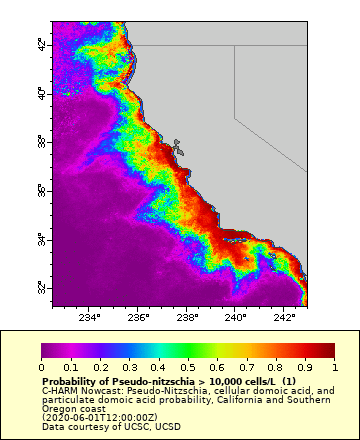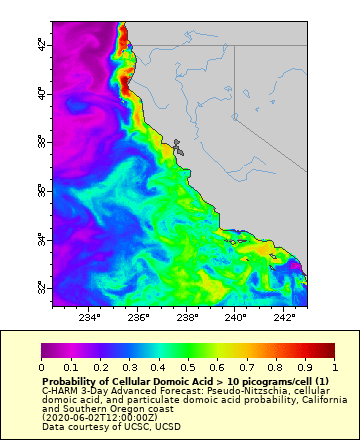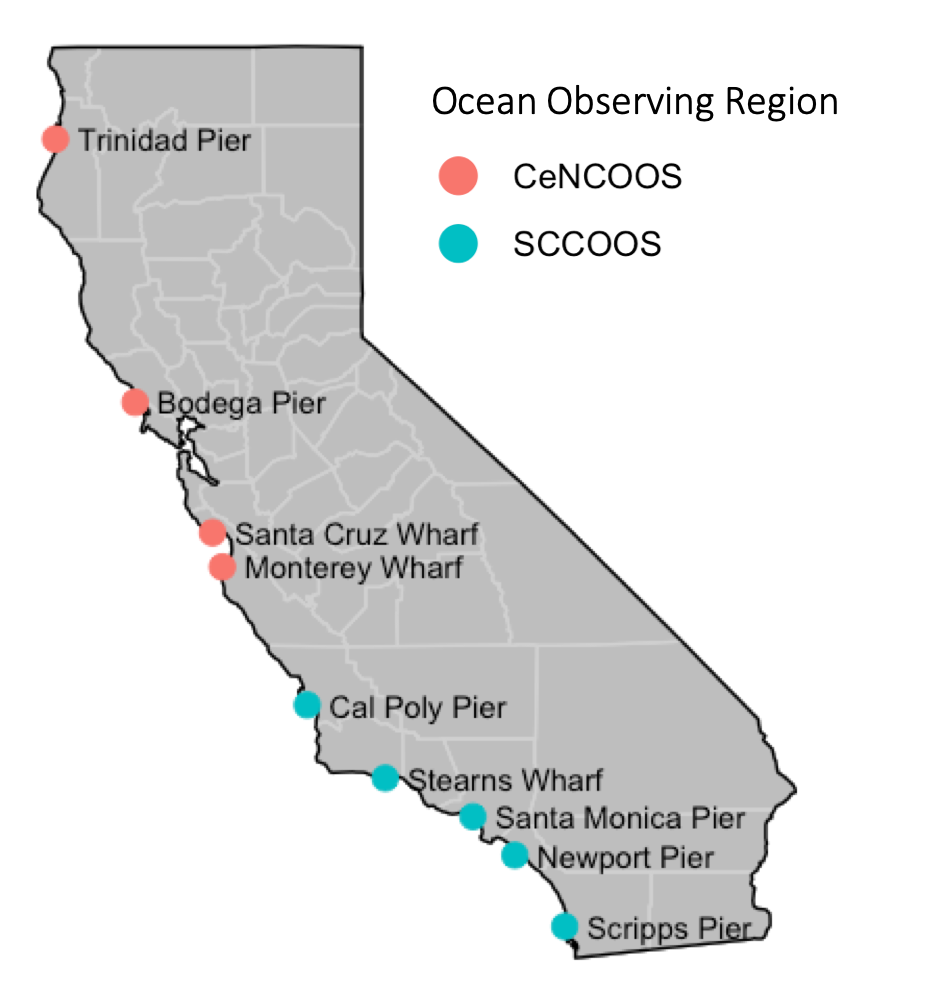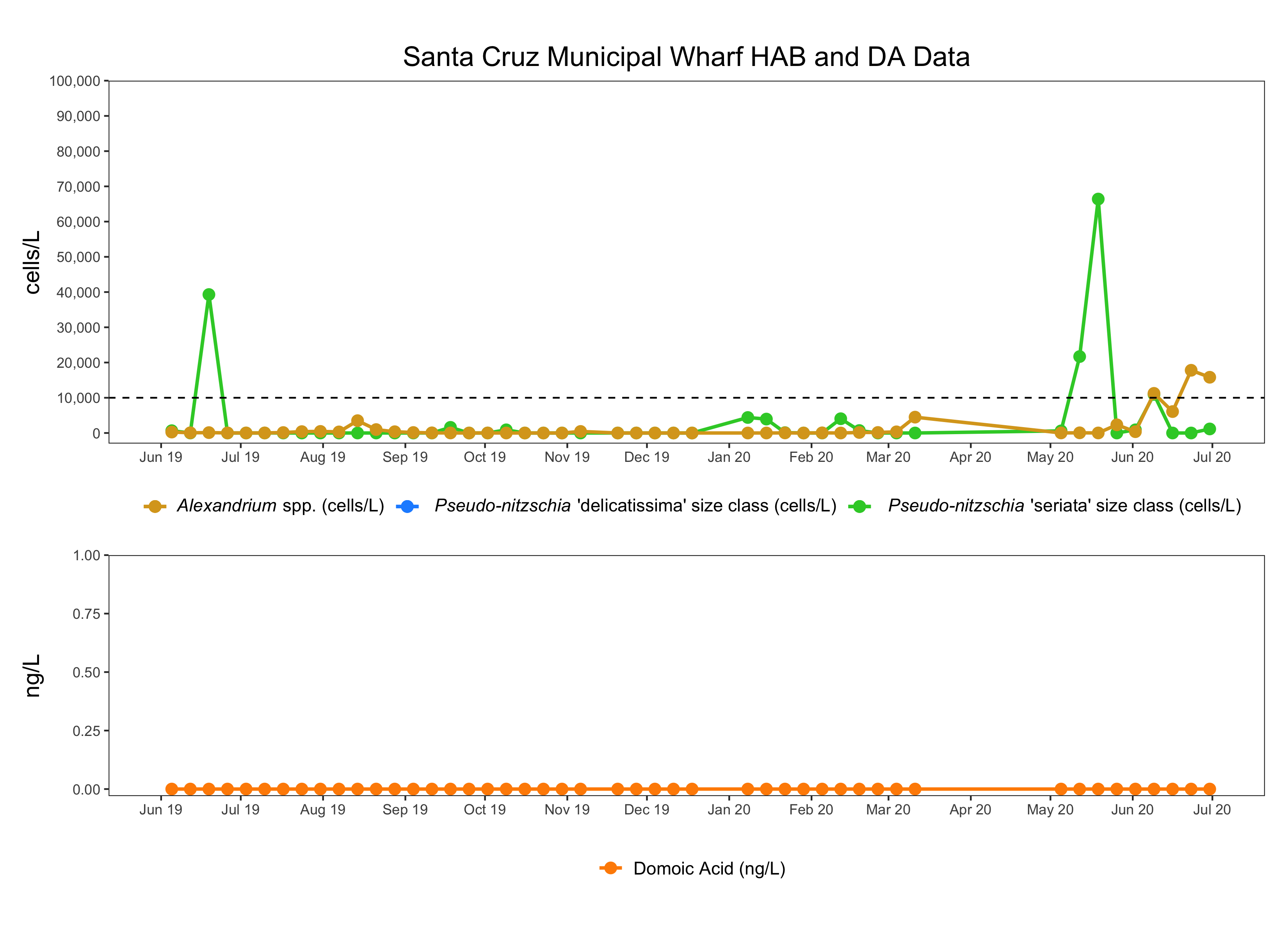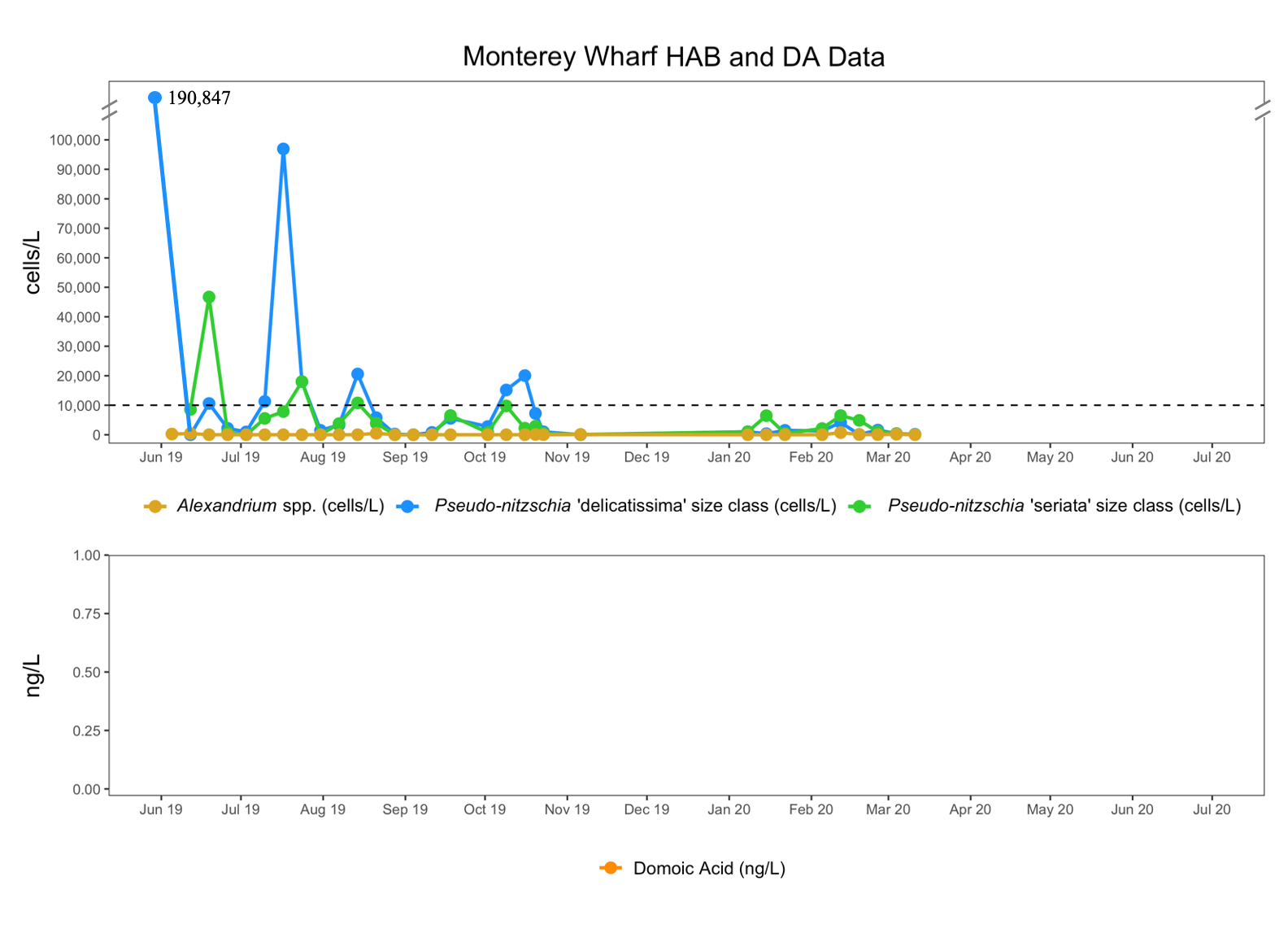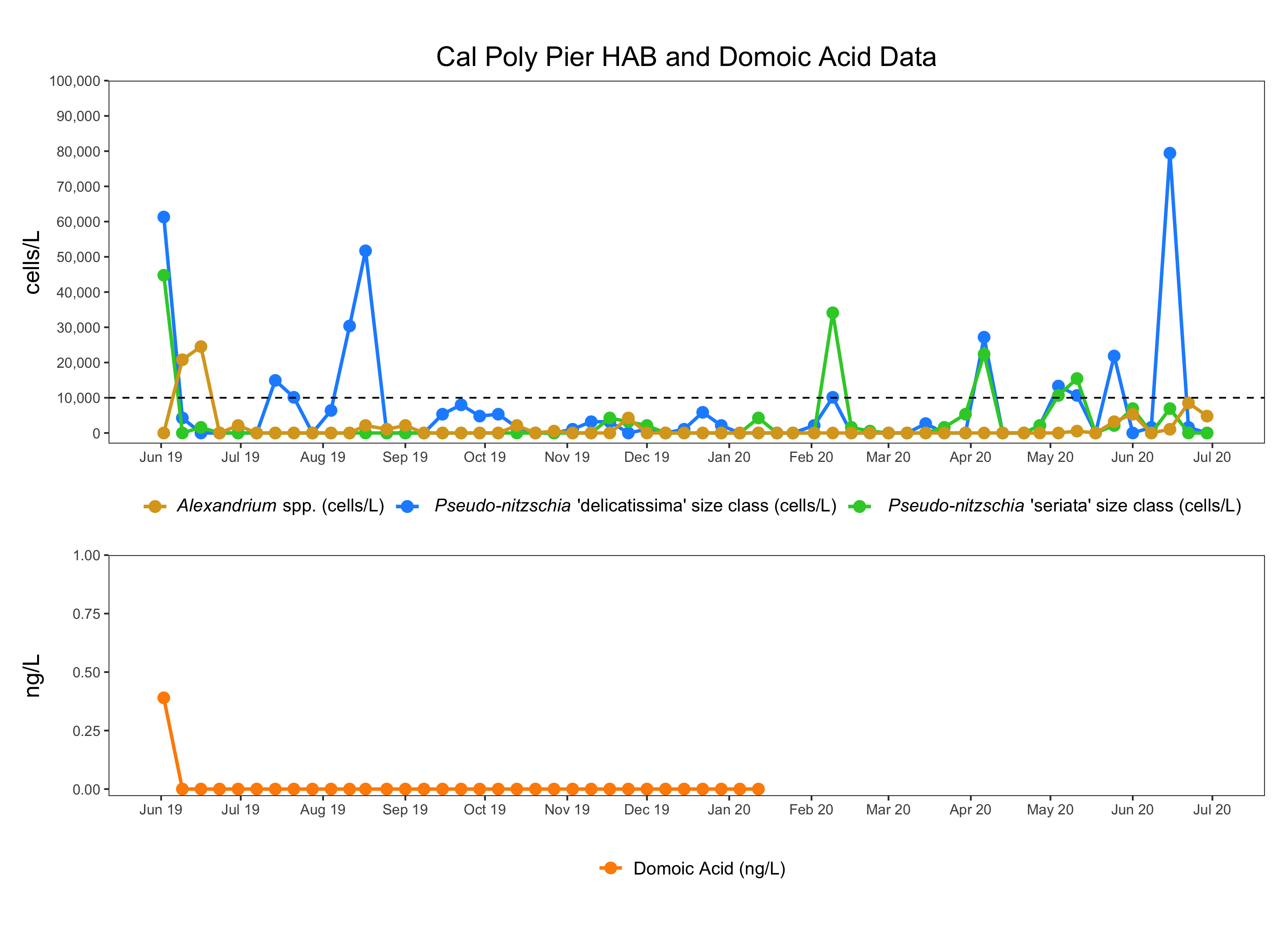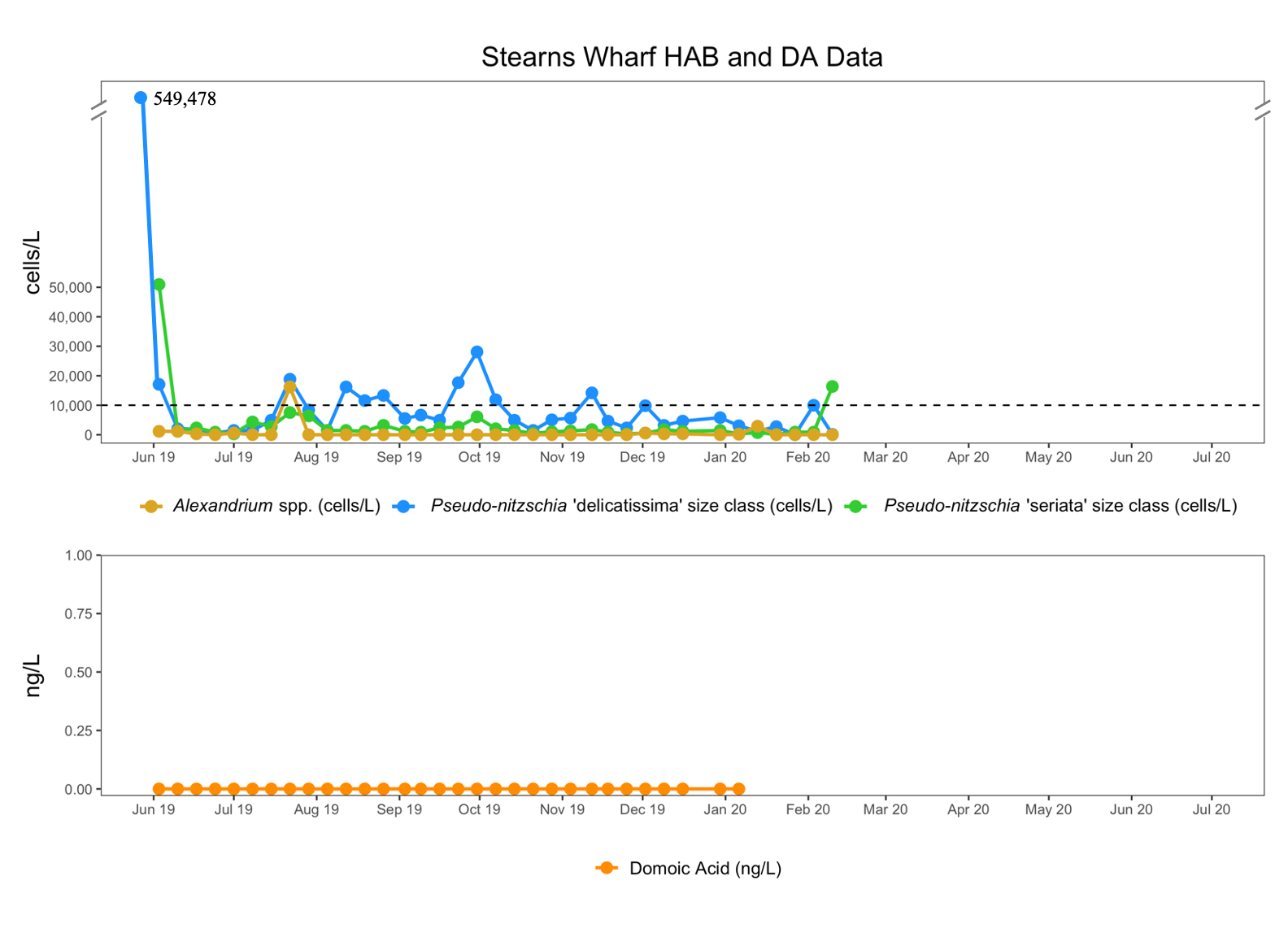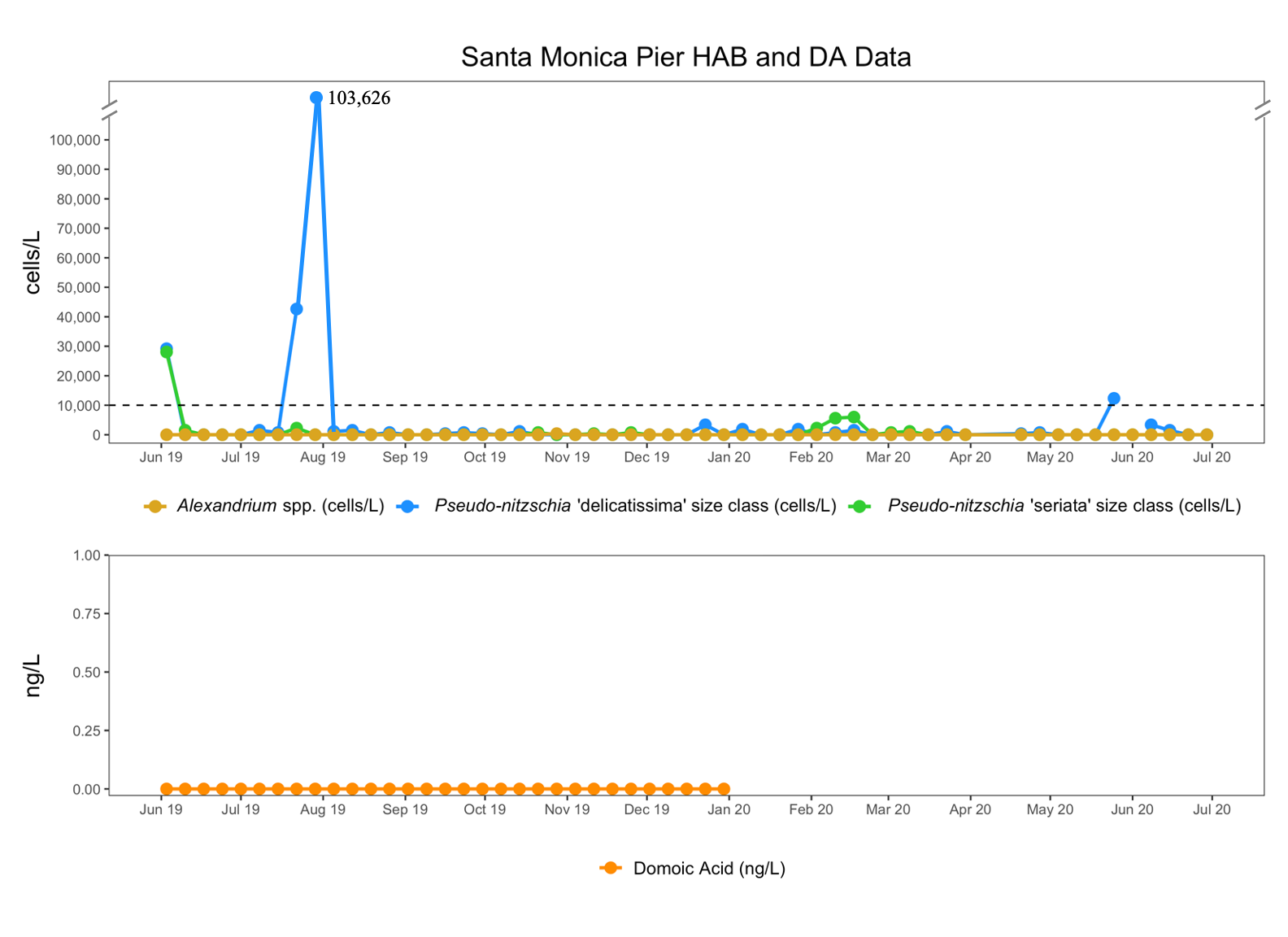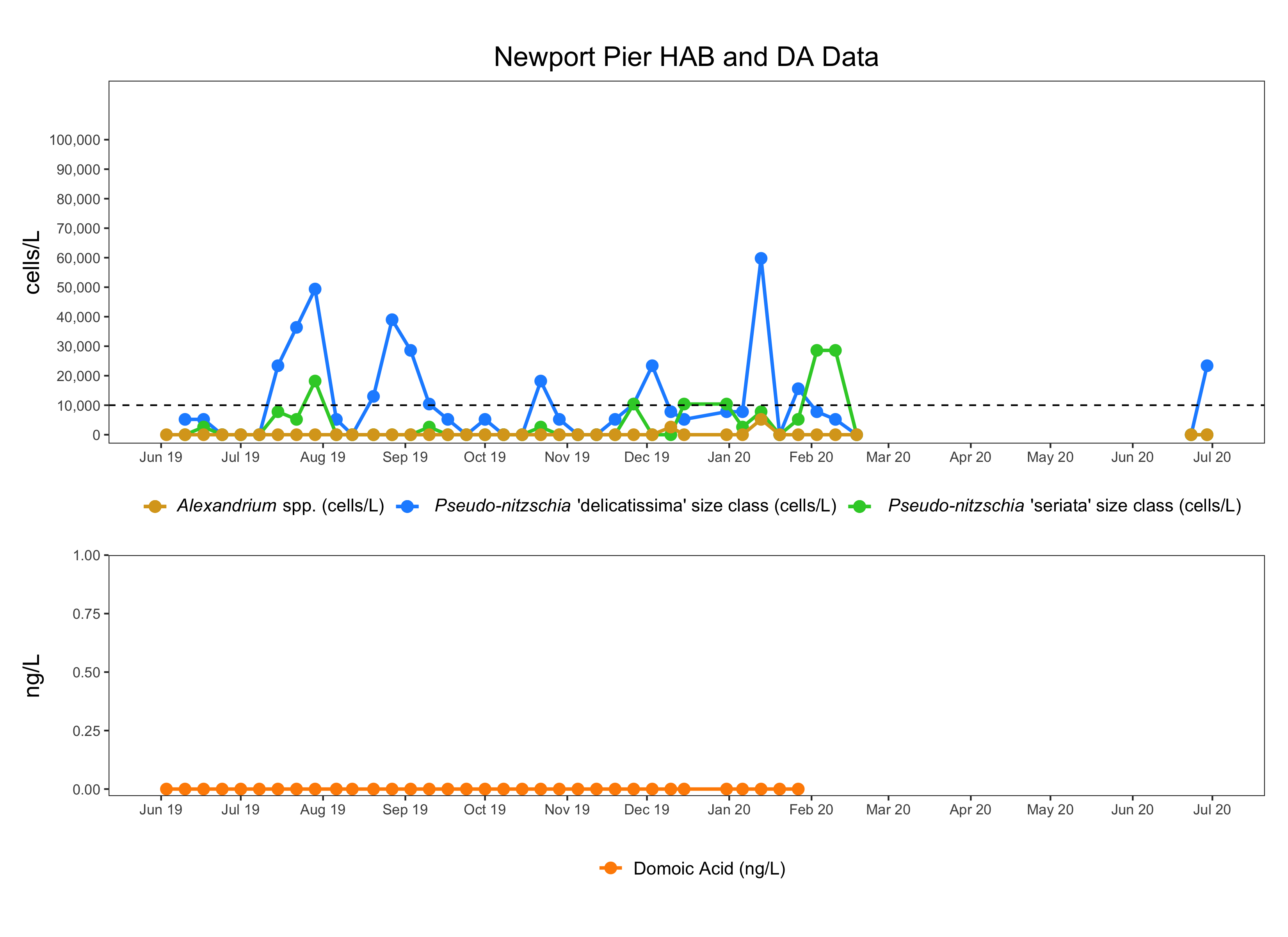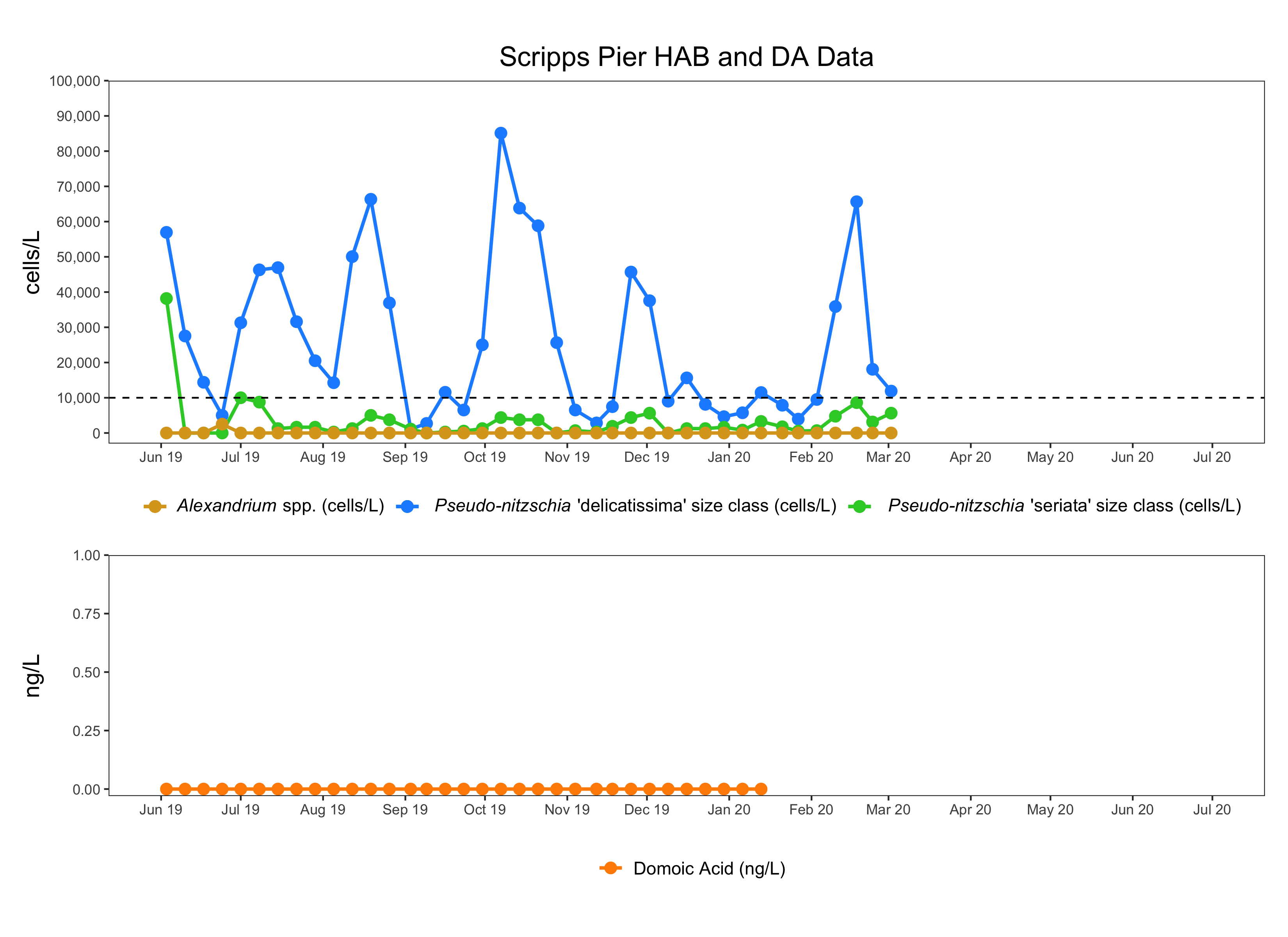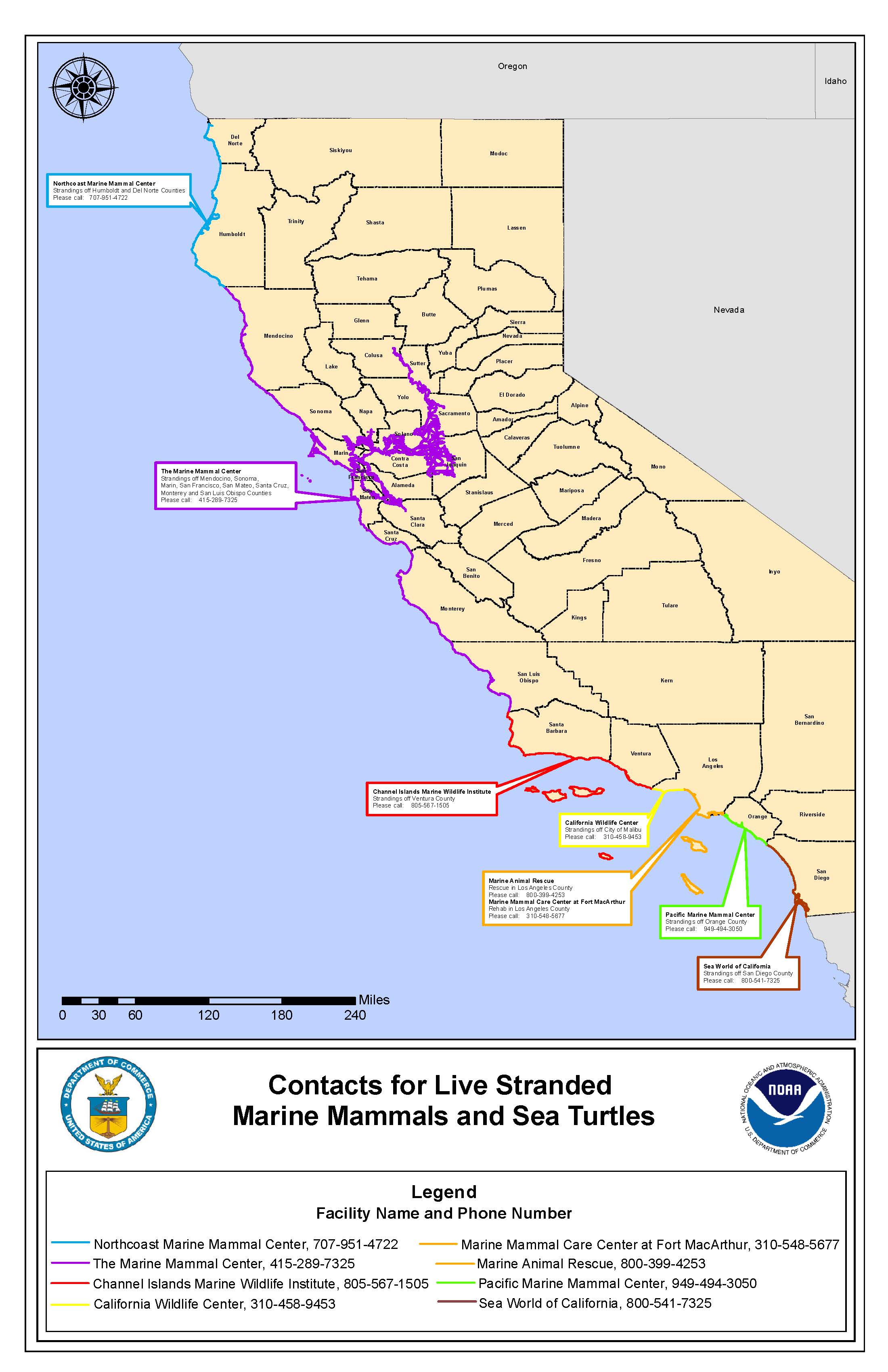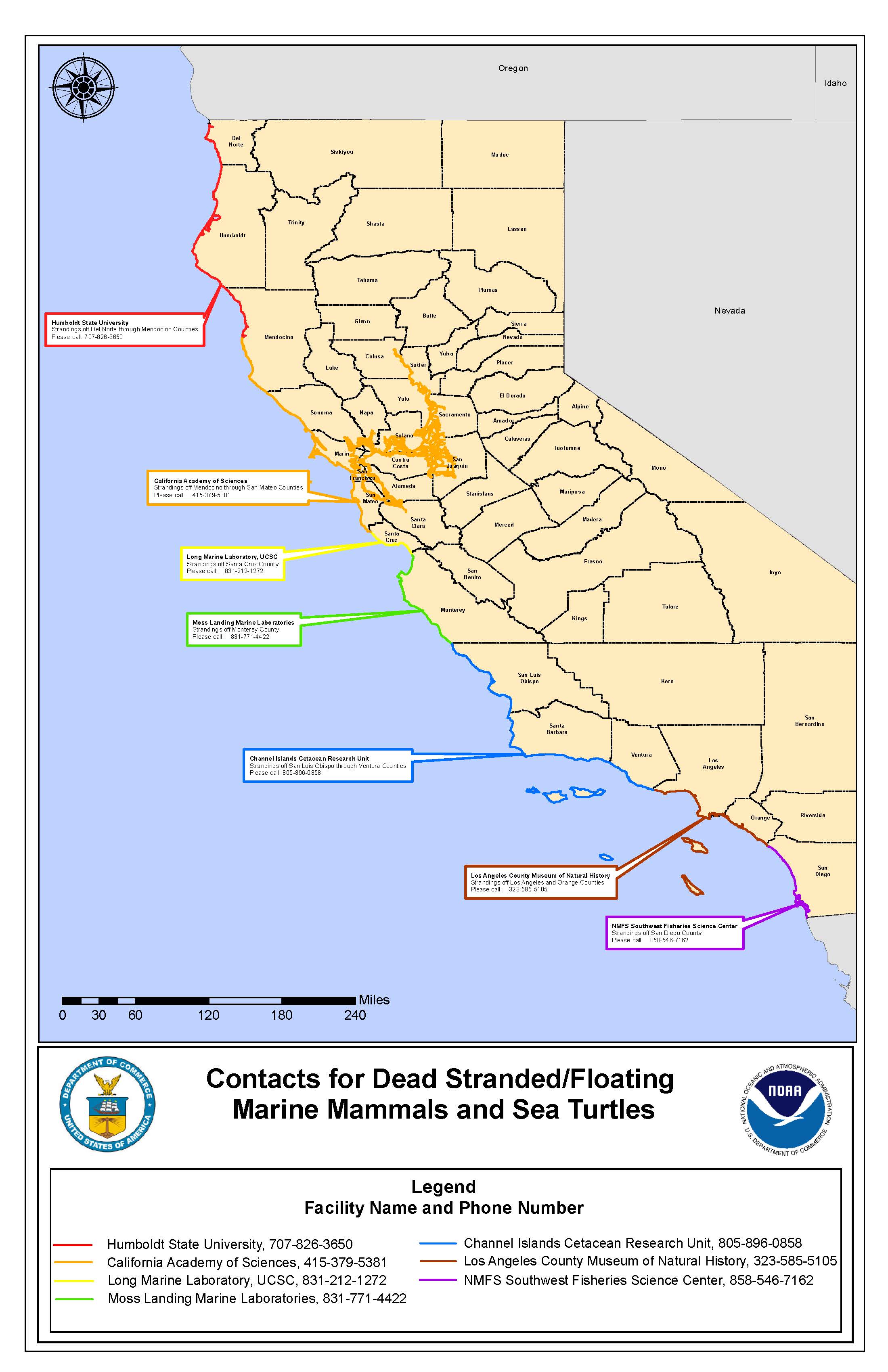Be sure to also read the special Red Tide Bulletin: Spring 2020
Pseudo-nitzschia - C-HARM tells us where conditions are suitable for species of the diatom Pseudo-nitzschia spp. (all size classes) to grow well and where they might be more likely to produce domoic acid (DA). The predicted suitable habitat for Pseudo-nitzschia spp. was spread around throughout coastal California in June, much like in previous months, with more widely distributed high probabilities for Pseudo-nitzschia blooms spread throughout the state. In general, the central and north coasts and the Santa Barbara Channel exhibited persistently high bloom probabilities. Bloom probabilities in the Southern California Bight were also high throughout the month, particularly in the nearshore zone, with some dips into very low probabilities skewed towards the end of the month. While COVID-19 sampling restrictions continue to hamper our ability to acquire HABMAP observations from piers, we do know that the more toxigenic Pseudo-nitzschia "seriata" size class exceeded the bloom threshold at the Santa Cruz Wharf in early June, consistent with the high C-HARM bloom probabilities for Monterey Bay. Observed abundance of both Pseudo-nitzschia "seriata" and the less toxigenic Pseudo-nitzschia "delicatissima" size class at Cal Poly Pier well exceeded bloom levels in mid-June, coinciding with the central CA peaks in bloom probability throughout June; abundances of the P. "seriata" class dipped just below the bloom threshold in late June. The only southern California site where we have observations for all of June is the Santa Monica Pier where the less toxigenic group Pseudo-nitzschia "delicatissima" well exceeded bloom levels (291,000 cells/L!!), consistent with high daily C-HARM probabilities in the LA county region during the month (caveat: the more toxigenic seriata group did not bloom at SM Pier). The toxigenic P. "seriata" size class exceeded bloom levels at Newport Beach Pier on the June 29th weekly sampling, consistent with elevated C-HARM probabilities that day. HABMAP samples were either not collected or data are not yet available for Monterey Wharf, Stearns Wharf, and Scripps Pier.
Moderate to high probabilities of particulate DA (pDA) were predicted for most of the California coast throughout June, with the Humboldt and Mendocino coast and offshore waters increasing in predicted intensity over the course of the month. Probabilities from Sonoma and Marin County to San Luis Obispo County exhibited local minima in pDA probabilities but never dropped below 60% probability of high pDA. The consistently high probabilities for pDA from Monterey Bay to San Francisco Bay and further north are consistent with the five California Sea Lion strandings reported by The Marine Mammal Center (TMMC) from Monterey to Marin Counties throughout June. The only available domoic acid measurements from HABMAP during June were collected at Santa Cruz Wharf and indicated no DA at that site, as has been the case for a year or more. This is inconsistent with C-HARM predictions for the Monterey Bay area. While much of the elevated pDA probabilities extended very far offshore, much like in May, predicted cellular DA (cDA) risk appeared to be contained in a fairly tight nearshore band for much of the coastline and was consistently high from northern San Luis Obispo County to the Oregon border. Measurements of DA are not yet readily available in that region for HABMAP, but the pDA and cDA predictions from C-HARM are consistent with the health advisories issued by the CDPH for domoic acid in razor clams in Del Norte and Humboldt Counties. The Southern California Bight exhibited much lower potential risk for cDA with high-probability patches appearing in and around the Santa Barbara Channel and the San Pedro Bay towards the end of the month. No marine mammal strandings were recorded for the Southern California Bight in June.
CDPH reported a high percent composition for the Pseudo-nitzschia "seriata" size class near Tomales Bay (Marin County).
Alexandrium - CDPH noted that Alexandrium spp. were very abundant at Pacifica Pier in mid-June and Monterey Bay in late June, consistent with similarly high (and alarming) abundances observed by HABMAP at Santa Cruz Wharf throughout June and rising into early July. Subsequent evaluation of saxitoxin in shellfish led the CDPH to issue health advisories for mussels, clams, and whole scallops in San Mateo, San Francisco, Santa Cruz, and Monterey Counties due to the threat of Paralytic Shellfish Poisoning.
*Please note that HABMAP sampling, CDPH sampling, and marine mammal rescues have been greatly reduced in response to COVID-19 safety measures.
**HABMAP sampling has been suspended since March 19th in accordance with the Governor's stay at home order to protect the health and well-being of all Californians and to help slow the spread of COVID-19. Cal Poly and Scripps received an exception to continue collecting water samples for the State and are taking the necessary safety measures to protect field personnel. The water samples are being preserved for future analysis by the Caron or Kudela Labs for domoic acid and Brzezinski/UCSB Marine Analytical Labs for macronutrients when it is safe for lab personnel to do so.**
Note that data for some stations are not shown because they are not yet recorded in the public HABMAP archive.
Differentiating Pseudo-nitzschia species by light microscopy is difficult. For this reason, Pseudo-nitzschia "seriata" does not refer to an actual species but rather the larger size class of Pseudo-nitzschia, which is generally a more toxigenic group of species. Alternatively, Pseudo-nitzschia "delicatissima" refers to the smaller size class that is generally non-toxigenic. The dashed line on the plots demarcates the 10,000 cells/L "bloom" threshold designated here for Pseudo-nitzschia populations only.
More information and data visualizations on the statewide HAB network and forecasting system can be found on the California HABMAP website and on the SCCOOS Harmful Algal Bloom page.
Water samples were collected at Santa Cruz Wharf five times in the month of June. Molecular probes for toxigenic Pseudo-nitzschia in the "seriata" class are conducted for this site, and was detected above bloom levels on June 9th. Alexandrium spp. were detected in all five samples. Domoic acid was not detected in any of the water samples.
The Santa Cruz Wharf shore station is supported by CeNCOOS PI Raphael Kudela at UCSC.
Water samples were collected five times at Cal Poly Pier in the month of June. Pseudo-nitzschia seriata was detected above bloom levels on June 15th and 29th and Pseudo-nitzschia delicatissima was detected above bloom levels on June 15th. Alexandrium spp. were detected in four of the five water samples and domoic acid results are not yet available.
Cal Poly Pier shore station is supported by SCCOOS PI Ryan Walter and Ally Pasulka at Cal Poly.
Water samples were collected four times at Santa Monica Pier in the month of June. Pseudo-nitzschia delicatissima was detected below bloom levels on June 8th and 15th. Pseudo-nitzschia seriata and Alexandrium spp. were not detected in any of the water samples and domoic acid results are not yet available.
Santa Monica Pier shore station is supported by SCCOOS PI Rebecca Shipe at UCLA.
Water samples were collected on June 23rd and 29th at Newport Beach Pier. Pseudo-nitzschia delicatissima group was detected above bloom levels on June 29th. Pseudo-nitzschia seriata and Alexandrium spp. were not detected in the samples. Domoic acid results aren't yet available.
Newport Beach Pier is supported by SCCOOS PI David Caron at USC.
CDPH observations for Pseudo-nitzschia 'seriata' and Alexandrium spp.
Please note CDPH recently moved to only reporting Pseudo-nitzschia of the seriata complex and not all Pseudo-nitzschia spp. as previously provided.
From 1-30 June 2020, water samples were collected by volunteers and sent to the California Department of Public Health (CDPH) for analysis. Pseudo-nitzschia seriata group was detected in 53 of the 95 samples. Pseudo-nitzschia seriata was detected at "Abundant" density levels (using CDPH relative abundance index) on June 1st at Tomales Bay in Marin County (45% composition). Alexandrium spp. were detected in 26 of the 95 samples in the month of June. Alexandrium spp. were detected at "Common" density levels on June 14th at Pacifica Pier (15% composition) and 24th at Monterey Bay (12% composition).
You can view an interactive map and data table of CDPH data from January 2019 to present developed by SCCOOS below or you can also view CDPH Toxic Phytoplankton Observations Map with layers of Pseudo-nitzschia and Alexandrium spp. as well as other phytoplankton species observations (in the pop-up windows).
Data are provided by the California Department of Public Health, Environmental Management Branch.
CDPH and OEHHA Health Advisories
California Department of Public Health (CDPH) annual quarantine of sport-harvest mussels began May 1, 2020. The quarantine is in place to protect the public against poisoning that can lead to serious illness, including coma and death. For the latest closures and updates, please visit the CDPH Health Advisories page as a central location of information related to CDPH health advisories. Also available is a map showing the current CDPH Recreational Bivalve Shellfish Advisories (see below).
Domoic acid (DA) is a potent neurotoxin produced by some diatom species of the genus Pseudo-nitzschia. Species exposed to DA can result in seizures, epilepsy, cardiomyopathy, and death depending upon the ingested dose. DA toxicosis commonly occurs in California Sea Lions (Zalophus californianus), presumably due to a combination of foraging behavior and seasonal movements. The Marine Mammal Center (TMMC), Channel Islands Marine Wildlife Institute (CIMWI), California Wildlife Center (CWC), Marine Mammal Care Center Los Angeles (MMCC-LA), Marine Animal Rescue (MAR), the Pacific Marine Mammal Center (PMMC), and SeaWorld act like an emergency room by working to rescue and rehabilitate sick and injured marine mammals, seabirds, and sea turtles.
Among the seven rehabilitation centers we received data for in the month of June a total of 5 marine mammal strandings presented with symptoms of domoic acid toxicosis.
The Channel Islands Marine Wildlife Institute (CIMWI), California Wildlife Center (CWC), Marine Animal Rescue (MAR), Marine Mammal Care Center-Los Angeles (MMCC-LA), Pacific Marine Mammal Center and SeaWorld did not record any strandings due to suspected domoic acid in June 2020.
June strandings due to suspected DA toxicosis occurred in the following counties:
- Marin County (TMMC)
- June 7th - adult, female, California Sea Lion
- Contra Costa County (TMMC)
- June 21st - juvenile, male, California Sea Lion
- San Mateo County (TMMC)
- June 2nd - pup, male, California Sea Lion
- Santa Cruz County (TMMC)
- June 8th - juvenile, male, California Sea Lion
- Monterey County (TMMC)
- June 12th - juvenile, male, California Sea Lion

